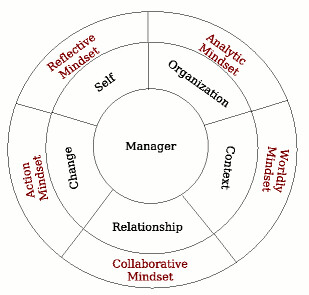AbstractThe separation of management from leadership has promoted hubris and its destructive implications
can be seen today’s organizations. There is some opposing aspects which has been told to the managers like be global as well as local. Be collaborative as well as competitive. Effective management needs to balance this seemingly contradicting concerns. To bring this balance managers need to develop “mindsets”. The authors have classified five aspects of a managerial mind. First, they explain how they came up with the mind-sets, they describe each in some depth and then the relationships between the mind-sets.
Why the mind-sets?Organizations often times come to situations when it knows what to execute but appropriateness of the execution in the situation may not be quite clear. A disconnect between “action” vs. “reflection” can be very dangerous for such circumstances. Authors call action without reflection as “thoughtless” and reflection
without action as“passive”. These actions need involvement of other people hence it needs “collaboration”. The action also needs to be modified based on the context or “worldly” view. And, no such act can be complete with an“analytic” mind-set. Considering these the authors have came up with five different mind-sets of a manager.
• Managing Self: Reflective mind-set
• Managing Organization: Analytic mindset
• Managing Context: Worldly mind-set
• Managing Relationships: Collaborative mind-set
• Managing Change: Action Mindset
The Reflective Mind-setIt’s important for a manager to internalize the facts rather than merely a spectator to the situation. Reflective mind-set brings in the happening and creates an ability to correlate it with self and thus to get a broader perspective of the situation. Reflection is not about mirroring people but about internalizing the happenings and create a deeper understanding. An empathetic view can closely describe this aspect.
The Analytic Mind-SetModern organizations in the essence have become highly structured and can be explained by a systemic approach. Division of labor and structured processes needs an analytical mindset to realize the systems, processes and their interconnections. However, managers need to interpret the soft data available around into the analytical framework as well rather than overtly stuck with numbers and values.
The Worldly Mind-SetWorldly mind-set needs a “glocal” view of the situation. While, it’s good to have a global view of the world the barriers in the world is lowering are facts. Substantial differences still exist in the local situations vs. global situations. Local customs, feelings, holidays, sentiments should be looked at as well while focusing on the global view as well. A cultural dissonance can affect employee morale, customer unhappiness and social balance. Managers need to take a worldly view so that a balance across can be managed.
Collaborative Mind-setCollaboration is about relationship building and providing a ground for people to exchange and work. It needs to change the manager at the top attitude and managing people. Rather the view point should more towards bringing in synergy across cross functional, far-located teams to be able to deliver.
The Action Mind-setThe business is facing change very rapidly. Similarly, every person in the organization also has aspirations, emotions and motives that vary drastically. Holding a steady course and bring in a direction is important to change. The action mind-set is not about to create a dictatorial fear among the teams but to understand the capabilities of the teams and the difficulty levels of the terrain and bring in a balance between both.
Bringing all the mind-sets togetherAll these mind-sets do not work in isolation. They need to be weaved together to create a balance. For example action and collaboration is a requirement to bring in synergy in the teams. When you get a road block reflections provide solutions to overcome. Then again more focused action with analysis of the activities will help in realizing the end objectives. A worldly mind-sets provides the needed balance all through the cycles. Although, it’s a necessity for all managers to show deep inclinations to all the mind-sets, typically managers tend to tilt towards a few of them. However, if these can be identified and the interweaving can be done at the organization levels, this can bring in enough balance in the organization.
References[1] Jonathan Gosling; Henry Mintzberg. The five minds of a manager. Harvard Business Review, pages 54–63, November 2003.
